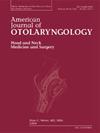Trans-oral robotic surgery in the management of malignant oropharyngeal minor salivary gland tumors: A systematic review
IF 1.7
4区 医学
Q2 OTORHINOLARYNGOLOGY
引用次数: 0
Abstract
Objective
The aim of this study is to evaluate trans-oral robotic surgery (TORS) in the treatment of oropharyngeal minor salivary glands (OPMSG) malignancies.
Methods
This study was performed according to the PRISMA statement. A systematic review was performed following a comprehensive electronic search in PubMed, Google Scholar and ScienceDirect databases for studies published until April 21st, 2024.
Results
Eleven studies were included in our analysis. A total of 180 patients (males: 44.8 %, n = 78/174) with a median age of 59.6 years (n = 174; IQR 53–72) who underwent OPMSG malignant tumor TORS resection were included. The most common histology was mucoepidermoid carcinoma (n = 76/161, 47.2 %), followed by adenoid cystic carcinoma (n = 42/161, 26.1 %) and polymorphous low-grade adenocarcinoma (n = 17/161, 10.6 %). 87.9 % of OPMSG were classified as T1-T2 (n = 153/174). The median hospitalization time was 4 days (n = 154; IQR 2–6.5). The median initiation of oral diet following surgery occurred on post-operative day 1 (n = 15; IQR 1–4). Post-operative complications, occurring within 30 days from the TORS procedure, presented in 5.8 % of cases (n = 10/172). Negative margins after resection of primary tumor were obtained in 80.4 % of cases (n = 139/173).
Conclusions
This systematic review confirms the safety and feasibility of TORS in the treatment of OPMSG malignancies. However, due to the low quality of included studies, further evidence is needed to establish clinical guidelines.
经口机器人手术治疗口咽小涎腺恶性肿瘤:系统综述
目的探讨经口机器人手术(TORS)治疗口咽小唾液腺(OPMSG)恶性肿瘤的效果。方法本研究按照PRISMA标准进行。在PubMed、b谷歌Scholar和ScienceDirect数据库中进行全面的电子检索,检索到2024年4月21日之前发表的研究,并进行系统评价。结果6项研究纳入我们的分析。共180例患者(男性44.8%,n = 78/174),中位年龄59.6岁(n = 174;纳入IQR 53-72)行OPMSG恶性肿瘤切除术的患者。最常见的组织学为粘液表皮样癌(n = 76/161, 47.2%),其次为腺样囊性癌(n = 42/161, 26.1%)和多形性低级别腺癌(n = 17/161, 10.6%)。87.9%的OPMSG分为T1-T2 (n = 153/174)。中位住院时间为4天(n = 154;差2 - 6.5)。术后开始口服饮食的中位时间为术后第1天(n = 15;差1 - 4)。术后并发症发生在TORS手术后30天内,5.8%的病例(n = 10/172)出现。原发肿瘤切除后阴性切缘占80.4% (n = 139/173)。结论本系统评价证实了tor治疗OPMSG恶性肿瘤的安全性和可行性。然而,由于纳入的研究质量较低,需要进一步的证据来建立临床指南。
本文章由计算机程序翻译,如有差异,请以英文原文为准。
求助全文
约1分钟内获得全文
求助全文
来源期刊

American Journal of Otolaryngology
医学-耳鼻喉科学
CiteScore
4.40
自引率
4.00%
发文量
378
审稿时长
41 days
期刊介绍:
Be fully informed about developments in otology, neurotology, audiology, rhinology, allergy, laryngology, speech science, bronchoesophagology, facial plastic surgery, and head and neck surgery. Featured sections include original contributions, grand rounds, current reviews, case reports and socioeconomics.
 求助内容:
求助内容: 应助结果提醒方式:
应助结果提醒方式:


